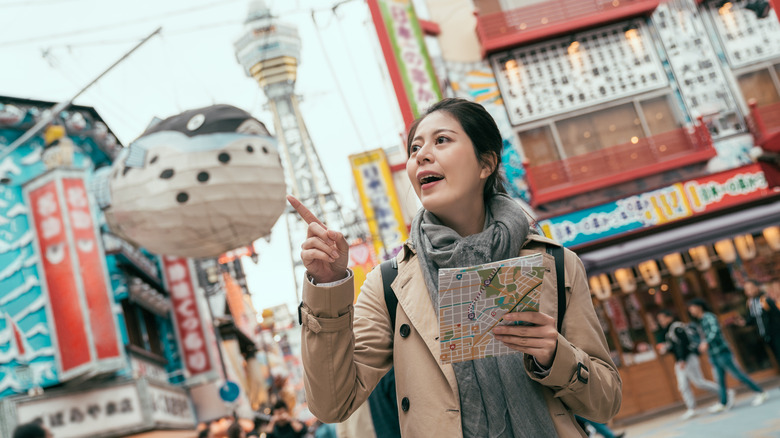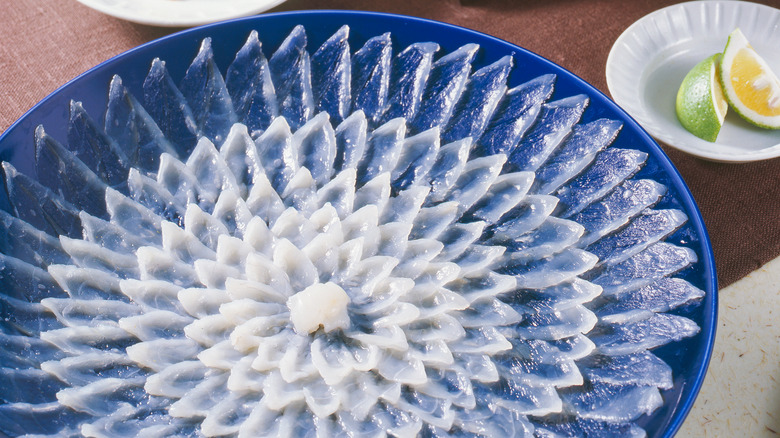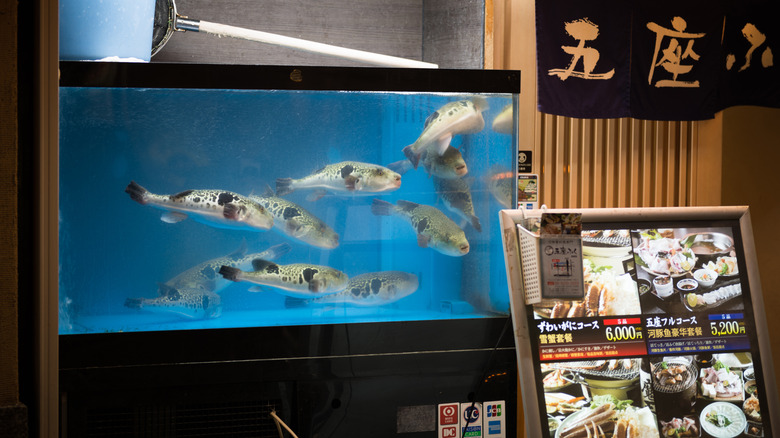The Iconic Food Tourists Are Better Off Ordering In Japan, If They're Brave Enough
There are many reasons why 33.1 million tourists visited Japan in 2023 (via JTB). Some come to witness natural landscapes and peaceful temples, while others visit to live out their ninja fantasies and people watch in Tokyo's Harajuku district. However, there's one thing everyone can agree on: Japan is a culinary wonderland, and among its special foods are certain dishes that tourists are better off ordering in the homeland. This can be none other than fugu, also known as pufferfish or blowfish — that is, if you're brave enough.
Per NOAA Fisheries, there are 100 species of fugu worldwide; nearly 25 of them are caught in Japanese seas, and only around half of them are actually edible. The most popular of these edible species are Tora-fugu (Tiger pufferfish), Ma-fugu (Japanese pufferfish), Shousai-fugu (Shousai pufferfish), and Karasu-fugu (Chinese pufferfish) — all of which are extremely poisonous. Their liver, ovaries, and sometimes muscles and skin contain tetrodotoxin, a neurotoxin that is one of the most lethal of its kind known to humans.
To put this danger into perspective, Hong Kong's Centre for Food Safety notes that 1 to 2 milligrams of tetrodotoxin would be enough to kill you. If there is no antidote, death is imminent within six hours. Eating fugu was banned in Japan from 1570 to 1870 because no one really knew how to properly "detoxify" the fish. However, in modern times, fugu — now legal — has developed quite the reputation as a delicacy, requiring highly skilled and licensed chefs to prepare it.
How fugu is prepared and served
To avoid serving a dangerous dish that can kill you, chefs must undergo a rigorous training and licensing process, which can take four to six years and involves practicing and preparing hundreds of fish. Additionally, there is an age restriction; chefs must be at least 20 years old. When it comes to preparing the fugu itself, the process involves cleaning, scaling, and carefully removing all the parts that contain tetrodotoxin. After this, the fish is filleted with precision to avoid puncture or contamination from the toxic parts. Lastly, an inspection occurs to ensure that no poisonous parts remain.
The most common way to have fugu is raw or "tessa," sashimi style. Daring foodies can expect this dish of Japanese roulette to be served with some flair. Most commonly, fugu sashimi is presented as a chrysanthemum or peony-shaped flower of thinly sliced shavings. Other popular dishes include hot pot "Fugu Nabe," grilled "Shirako," or fried "Fugu no Karaage."
The taste of fugu is said to have an umami flavor — delicate, subtle, with a slightly chewy texture. Surprisingly, the meat doesn't have much of a fishy smell either and is described as having a light and refreshing feel. But be careful; in Japan, every year, about 20 to 40 instances of fugu poisoning occur, reminding many of the skill required to prepare it. However, it should be noted that nearly all fatalities since 2000 were as a result of home preparation.
The best places to try fugu in Japan
If you're going to try fugu anywhere, consider having it at the first restaurant in Japan to be officially licensed: Shunpanro in Shimonoseki. It is reported that in 1887, Itō Hirobumi, the first prime minister of Japan, changed both his mind and country's laws after eating the dish of fugu prepared for him there. Hence, the ban was lifted in 1888, and Shimonoseki was granted the title "home of fugu."
When it comes to pricing, it depends on where you are. For example, at a Japanese restaurant in Tokyo, Fugu can cost anywhere from ¥10,000 to ¥30,000 ($63 to $190), whereas if dining in areas where fugu is produced, like Kyushu, Chūgoku, and Shikoku, you can certainly find it for cheaper. For a one-of-a-kind visit, however, check out the Karato Fish Market, a seaside food mall where local fishermen sell their freshest catches — including fugu and large amounts of it! A plate of fugu sashimi goes for around ¥1000 ($7).
Additionally, an event called Ikiiki Bakanga invites visitors to experience open-air restaurants, tasting freshly caught fish as they come in. It is conveniently located within a few minutes walk from the Sanden Transportation Karato bus stop and can be accessed by ferry. The market is open on weekends and national holidays. This serves as a great opportunity to immerse yourself among the local seafood devotees of Japan while daring to try one of its most famous deadly delicacies!


